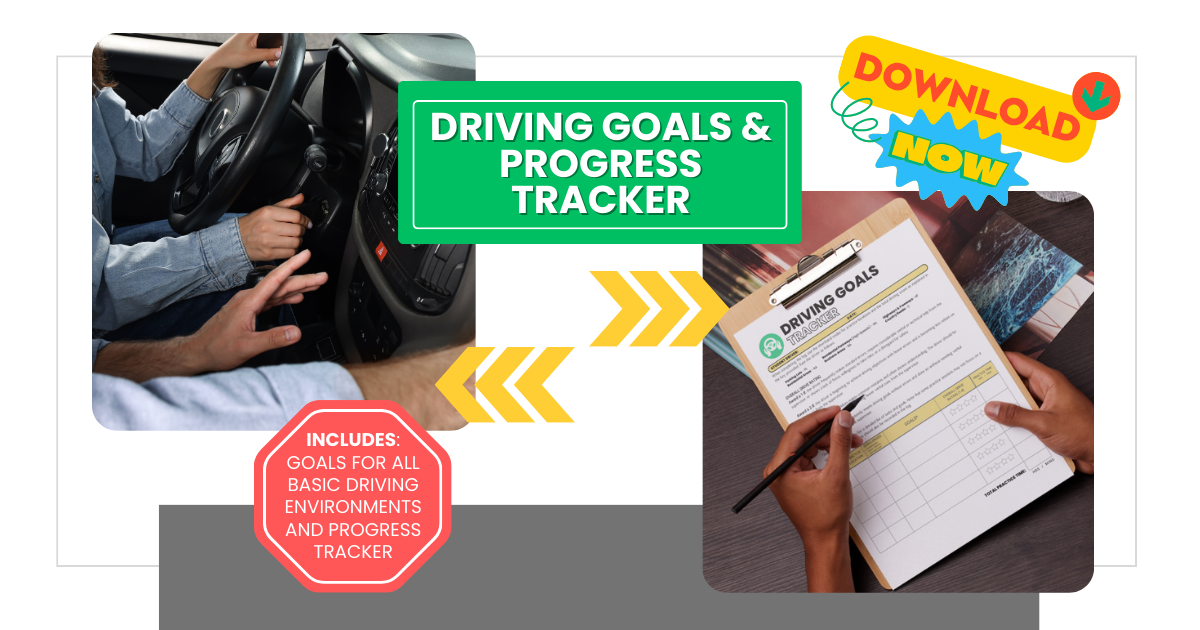Uncontrolled Intersections | RESIDENTIAL AREAS
| Driving Lessons |
Turning in residential areas may seem straightforward, but it requires careful attention to detail and an understanding of right-of-way rules to ensure safety. This guide is designed to help new drivers maintain the correct position within their lane during turns, especially emphasizing speed and steering control.
Goal for Making Turns
The new driver will learn to maintain the correct position for the car within a lane during turns, focusing on speed and steering control.
The Learning Environment
Look for a quiet residential neighborhood with very little traffic and few parked cars, pedestrians, lane markings, and intersections. Schedule practice during the day with dry pavement and no adverse weather.
Materials Needed
The Supervised Driving Log (Optional): Although it was originally created for California Teens Learning to Drive, this FREE and COMPLEMENTARY driving log is an essential tool for all new drivers. Keeping a driving log is great for tracking how you’re doing, finding what you need to get better at, and feeling good about your wins. It helps you learn in an organized way, focusing on key skills to make you a better driver faster. This careful tracking builds confidence and speeds up your path to driving well.
Understanding Intersections and Right-of-Way
Before hitting the road, it’s essential to review the basics of intersections and right-of-way rules for making turns. This foundation will not only make the practical exercises more effective but also ensure that you’re equipped to handle real-world driving situations confidently.
Activity Steps for Making Turns
Activity 1: The Commentary Drive
A commentary drive is an excellent way to start. Here, the driving coach demonstrates proper turning techniques while explaining their actions out loud. This includes how to operate the steering wheel and control speed during both right and left turns.
Initial Setup
- With the car stationary, the student driver should sit in the driver’s seat with the engine on, the gear in PARK, and the parking brake engaged.
- Practice signaling and turning the wheel at least one full turn, then smoothly returning the wheel to its original straight position.
- The driving coach should give directions to turn right or left while the student driver perform each manuever and unwind to complete the practice, demonstrating how the lesson will be conducted.
Activity 2: Practice Turns in a Residential Neighborhood
Step 1: Signal Your Intentions
Always indicate your intended direction well in advance using your turn signal. This simple action communicates your plans to other road users, helping to prevent accidents.
Step 2: Check Mirrors and Blind Spots
Before making your turn, it’s critical to check both your mirrors and the blind spot on the side you’re turning towards. This ensures the way is clear and you’re not cutting off another vehicle or endangering pedestrians.
Step 3: Slow Down Before the Turn
Reduce your speed to about 10-15mph before the turn. This allows you to maintain speed control of the vehicle throughout the maneuver.
Step 4: Use Turn Lanes When Available
If there’s a designated turn lane, make sure to enter it in a timely manner. This helps streamline traffic flow and reduces confusion among other drivers.
Step 5: Scan for Hazards
Always scan for other vehicles, pedestrians, and potential hazards. Residential areas can be unpredictable, with children playing near the street or cars pulling out of driveways. Be preapred to share the road with others.
Step 6: Be Prepared to Stop
Approach every corner with the readiness to stop if necessary. Visibility around corners can be limited, and unexpected obstacles can emerge.
Step 7: Look Into Your Turn
As you approach the turn, try to look as far into your intended path as possible. This helps you anticipate and prepare for any adjustments in your course.
Step 8: Smooth and Controlled Maneuver
Execute the turn at a controlled speed, smoothly turning the wheel. This precision ensures a safe turn without veering off your intended path.
Step 9: Unwind and Accelerate Gradually
After completing the turn, smoothly unwind the steering wheel to straighten your vehicle and gradually accelerate to the appropriate speed, considering both road and weather conditions.
Common Errors to Avoid
New drivers often make a few common mistakes when dealing with making right or left turns:
-
- Entering a turn too fast can lead to loss of control.
- Oversteering or understeering affects your trajectory and can lead to accidents.
- Incorrect lane or lane position before or after a turn creates confusion and hazards on the road.
- Lack of knowledge regarding right-of-way or crossing intersections can result in dangerous situations.
Signs the Learner Gets It
A learner who successfully controls the vehicle while observing right-of-way procedures during turns demonstrates a clear understanding of these crucial driving skills. Mastery of turning in residential areas is a significant step toward becoming a confident and safe driver.
Use a progress tracker to keep track of skills that have been mastered and those that still need practice or improvement. Express Driving School proudly offers a Driving Skills and Goals Progress Tracker to help student drivers and their driving coaches with assessments and evaluations by providing a rating scale that is simple and easy to use.
Making Turns | RESIDENTIAL AREAS
Mastering the skill of making turns in residential areas is crucial for ensuring the safety of both the driver and surrounding pedestrians. By following a systematic approach—signaling intentions, checking mirrors and blind spots, slowing down appropriately, and smoothly executing turns—drivers can navigate these areas with confidence. Regular practice, combined with heightened awareness and adherence to right-of-way rules, will not only improve driving proficiency but also contribute to a safer driving environment for everyone. Remember, the key to successful driving lies in the details, and mastering the basics of turning is a fundamental step towards becoming a proficient and responsible driver.
Drive with Confidence!
Keep up with all the latest driving news. Expolre our blog packed with essential tips and expert advice on all things related to DRIVING!



